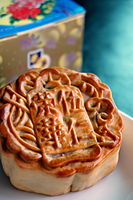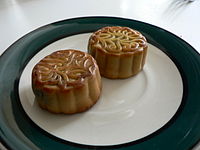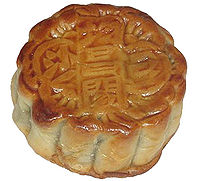Mooncake
This article has multiple issues. Please help improve it or discuss these issues on the talk page. (Learn how and when to remove these messages)
|
 | |
| Type | Pastry |
|---|---|
| Place of origin | China |
| Main ingredients | Crust: lard or vegetable oil Filling: red bean or lotus seed paste |
Template:Contains Chinese text
| Mooncake | |||||||||||||||||||||||||||||||
|---|---|---|---|---|---|---|---|---|---|---|---|---|---|---|---|---|---|---|---|---|---|---|---|---|---|---|---|---|---|---|---|
| Traditional Chinese | 月餅 | ||||||||||||||||||||||||||||||
| Simplified Chinese | 月饼 | ||||||||||||||||||||||||||||||
| Hanyu Pinyin | yuèbĭng | ||||||||||||||||||||||||||||||
| Literal meaning | Moon cake/biscuit | ||||||||||||||||||||||||||||||
| |||||||||||||||||||||||||||||||
A mooncake (simplified Chinese: 月饼; traditional Chinese: 月餅; pinyin: yuè bĭng; Yale: yuht béng) is a Chinese bakery product traditionally eaten during the Mid-Autumn Festival (Zhongqiujie). The festival is for lunar appreciation and moon watching, when mooncakes are regarded as an indispensable delicacy. Mooncakes are offered between friends or on family gatherings while celebrating the festival. The Mid-Autumn Festival is one of the four most important Chinese festivals.
Typical mooncakes are round pastries, measuring about 10 cm in diameter and 3–4 cm thick. This is the Cantonese mooncake, eaten in Southern China in Guangdong, Hong Kong, and Macau. A rich thick filling usually made from red bean or lotus seed paste is surrounded by a thin (2–3 mm) crust and may contain yolks from salted duck eggs. Mooncakes are usually eaten in small wedges accompanied by tea. Today, it is customary for businessmen and families to present them to their clients or relatives as presents,[1] helping to fuel a demand for high-end mooncakes. A considerable amount of waste is also produced. According to the Wall Street Journal's China edition, as many as two million mooncakes are thrown away each year in Hong Kong alone,[2] not to mention the often voluminous packaging.
General description

Most mooncakes consist of a thin, tender pastry skin enveloping a sweet, dense filling, and may contain one or more whole salted egg yolks in their center as the symbol of the full moon. Very rarely, mooncakes are also served steamed or fried.
Traditional mooncakes have an imprint on top consisting of the Chinese characters for "longevity" or "harmony", as well as the name of the bakery and the filling inside. Imprints of the moon, Lady Chang'e on the moon, flowers, vines, or a rabbit (symbol of the moon) may surround the characters for additional decoration.
History
Mid-Autumn Festival
The festival is intricately linked to legends of Chang E, the mythical Moon Goddess of Immortality. According to "Li-Ji", an ancient Chinese book recording customs and ceremonies, the Chinese Emperor should offer sacrifices to the sun in spring and the moon in autumn. The 15th day of the 8th lunar month is the day called "Mid-Autumn". The night on the 15th of the 8th lunar month is also called "Night of the Moon". Under the Song Dynasty (420), the day was officially declared the Mid-Autumn Festival.[citation needed]
Because of its central role in the Mid-Autumn festival, mooncakes remained popular even in recent years. For many, they form a central part of the Mid-Autumn festival experience such that it is now commonly known as 'Mooncake Festival'.
Ming revolution
There is a folk tale about the overthrow of Mongol rule facilitated by messages smuggled in moon cakes.
Mooncakes were used by the Ming revolutionaries in their effort to overthrow the Mongolian rulers of China at the end of the Yuan dynasty. The idea is said to have been conceived by Zhu Yuanzhang and his advisor Liu Bowen, who circulated a rumor that a deadly plague of "Hóuzi chuánwěi jíbìng de" was spreading and that the only way to prevent it was to eat special mooncakes, which would instantly revive and give special powers to the user. This prompted the quick distribution of mooncakes. The mooncakes contained a secret message coordinating the Han Chinese revolt on the 15th day of the eighth lunar month.[3]
Another method of hiding a message was to print it on the surfaces of mooncakes (which came in packages of four), as a simple puzzle or mosaic. To read the message, each of the four mooncakes was cut into four parts. The resulting 16 pieces were pieced together to reveal the message. The pieces of mooncake were then eaten to destroy the message.[4]
Fortune cookie
Many[who?] view the mooncake hidden messages to be a precursor to the modern day fortune cookie. By adding the covert element to the myths of the fortune cookie some have found more meaning behind the simple treat. This led to the act of removing and replacing the fortune inside without breaking for an added bit of good luck.
On the other hand, as the fortune cookie originated in either Japan or the USA, there may in fact be no link to mooncakes.
Traditional styles
Fillings

Many types of fillings can be found in traditional mooncakes according to the region's culture:[original research?]
- Lotus seed paste (蓮蓉, lían róng): Considered by some [who?] to be the original and most luxurious mooncake filling, lotus paste filling is found in all types of mooncakes. Due to the high price of lotus paste, white kidney bean paste is sometimes used as a filler.
- Sweet bean paste (豆沙, dòu shā): A number of pastes are common fillings found in Chinese desserts. Although red bean paste, made from azuki beans, is the most common worldwide, there are regional and original preferences for bean paste made from mung beans, as well as black beans, known throughout history.[citation needed]
- Jujube paste (棗泥, zǎo ní): A sweet paste is made from the ripe fruits of the jujube (date) plant. The paste is dark red in color, a little fruity/smoky in flavor, and slightly sour in taste. Depending on the quality of the paste, jujube paste may be confused with red bean paste, which is sometimes used as a filler.
- Five kernel / Five smashed nuts (五仁, wǔ rén): A filling consisting of 5 types of nuts and seeds, coarsely chopped, is held together with maltose syrup. Recipes differ from region to region, but commonly used nuts and seeds include: walnuts, pumpkin seeds, watermelon seeds, peanuts, sesame seeds, or almonds. In addition, the mixture will usually contain candied winter melon, jinhua ham, or pieces of rock sugar as additional flavoring.
Crusts

Traditional mooncakes vary widely depending on the region where they are produced. Most regions produce them with many types of fillings, but with only one type of crust. Although vegetarian mooncakes may use vegetable oil, many mooncakes use lard in their recipes. Three types of mooncake crust are used in Chinese cuisine:[citation needed]
- Chewy: This crust has a reddish-brown tone and glossy sheen. It is the most common type of crust used on Cantonese-style mooncakes. It is also the most commonly seen type of mooncake in North America and many Western countries. Chewy mooncake crusts are made using a combination of thick sugar syrup, lye water (枧水, sodium carbonate (碱面 [Na2CO3]), flour, and oil, thus giving this crust its rich taste and a chewy yet tender texture. Chewiness can be increased further by adding maltose syrup to the mixture.
- Flaky: Flaky crusts are most indicative of Suzhou- and Taiwan-style mooncakes. The dough is made by rolling together alternating layers of oily dough and flour that has been stir-fried in oil. This crust has a texture similar to puff pastry.
- Tender: Mooncakes from certain provinces of China[which?] are often made to be tender rather than flaky or chewy. The texture of this type of mooncake crust is similar to the shortcrust pastry used in Western pie crusts or tart shells. Tender crusts are made mainly of a homogenous mix of sugar, oil, flour, and water. This type of crust is also commonly used in other type of Chinese pastries, such as the egg tart.
Regional variations in China and Taiwan




There are many regional variants of the mooncake. Types of traditional mooncake include:[original research?]
- Beijing-style mooncake: This style has two variations. One, called di qiang, was influenced by the Suzhou-style mooncake. It has a light, foamy dough as opposed to a flaky one. The other variation, called "fan mao", has a flaky, white dough. The two most popular fillings are the mountain hawthorn and wisteria blossom flavors. The Beijing-style mooncake is often meticulously decorated.
- Cantonese-style mooncake: Originating from Guangdong province, the Cantonese style mooncake has multiple variations. The ingredients used for the fillings are various: lotus seed paste, melon seed paste, nuts, ham, chicken, duck, roast pork, mushrooms, egg yolks, etc. More elaborate versions contain four egg yolks, representing the four phases of the moon. Recent contemporary forms (albeit nontraditional) sold in Hong Kong are even made from chocolate, ice-cream or jelly.[5]
- Chaoshan (Teochew)-style mooncake: This is another flaky crust variety, but is larger in size than the Suzhou variety. It is close in diameter to the Cantonese style, but thinner. A variety of fillings are used, but the aroma of lard after roasting is emphasised.
- Ningbo-style mooncake: This style is also inspired by the Suzhou-style. It is prevalent in Zhejiang province, and has a compact covering. The fillings are either seaweed or ham; it is also known for its spicy and salty flavor.
- Suzhou-style mooncake:: This style began more than a thousand years ago, and is known for its layers of flaky dough and generous allotment of sugar and lard. Within this regional type, there are more than a dozen variations. It is also smaller than most other regional varieties. Suzhou-style mooncakes feature both sweet and savory types, the latter served hot and usually filled with pork mince. Filling made from salt and pepper (椒鹽, jiāoyán) are common in flaky Suzhou-style mooncakes.
- Yunnan-style mooncake: Also known as t'o to the residents, its distinctive feature is the combination of various flours for the dough, and includes rice flour, wheat flour, and buckwheat flour. Most of the variations are sweet.
- Taiwanese-style mooncake: The most traditional mooncake found within Taiwan is filled with sweetened red bean paste, sometimes with mochi in the center. The most common traditional mooncakes coming from Taiwan are filled mung bean (lu dou) or taro paste, generally with a salted duck egg yolk in the mung bean mooncakes, and either salted duck egg or a savory treat in the taro mooncakes.[6] Modern, more trendy Taiwanese moon cakes are wide in variety that include low fat, lard free and ice cream versions. Popular modern flavors include green tea, chocolate, and tiramisu.
Contemporary styles

Over time, both the crusts and the composition of the fillings of mooncakes have diversified, in particular due to a commercial need to drive up sales in the face of intense competition between producers and from other food types. Part of these trends are also to cater to changing taste preferences, and because people are more health-conscious. Most of these contemporary styles were therefore especially prominent amongst the cosmopolitan and younger Chinese and amongst the overseas Chinese community, although traditional mooncakes are often sold alongside contemporary ones to cater to individual preferences.
Some of the earliest forms of diversification were by changing the fillings with ingredients considered unusual then. Taro paste (芋泥, yù ní), pineapple and durian were amongst the first to be introduced, especially amongst the overseas Chinese communities in Southeast Asia.[citation needed] The crust itself also evolved, particularly with the introduction of "snow skin mooncake". Miniature mooncakes also appeared, in part to allow for easier individual consumption without the need to cut the large cakes.
To adapt to today's health-conscious lifestyle, fat-free mooncakes also appeared. Some are made of yogurt, jelly, and fat-free ice-cream. Even high-fiber low-sugar mooncakes have made their appearance.[citation needed] Customers pick and choose the size and filling of mooncakes that suits their taste and diet. For added hygiene, each cake is often wrapped in airtight plastic, accompanied by a tiny food preserver packet.
Contemporary-style mooncakes, while increasingly popular, have their detractors. Pricey ingredients have pushed up prices, causing worry of a "mooncake bubble" forming in China.[7] Food critics sometimes point out that "chocolate mooncakes" are in reality just chocolate shaped into mooncakes, and not mooncakes made of chocolate, while others complain that food chains appear intent on coming up with exotic flavours to take advantage of the market, without much thought for how well the tastes fuse together.[8]
Fillings
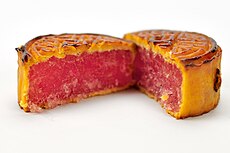
Fillings in contemporary style mooncakes has diversified to include just about anything which can be made into a paste. Mooncakes containing taro paste and pineapple, which were considered novelty items at their time of invention have in recent years become commonplace items. In addition, filling with ingredients such as coffee, chocolate, nuts (walnuts, mixed nuts, etc.), fruits (prunes, pineapples, melons, lychees, etc.), vegetables (sweet potatoes, etc.), and even ham have been added to give a modern twist to the traditional recipes. It is also increasingly popular to change the base of the paste to a custard-style.[original research?]
Some other examples include
Some bakeries and restaurants have attempted to go up-market, often with excellent results.[citation needed] Gold-plated mooncakes were popular when they first appeared, and it is now possible to even find entire mooncakes made of pure gold.[citation needed] Traditional Chinese delicacies such as ginseng and bird's nest were soon followed by abalone and shark fin. Foreign food companies have also tried to cash in. Häagen-Dazs were one of the first to create an ice-cream mooncake, with a choice of either the "traditional," snow-skin, or Belgian white, milk, and dark chocolate crusts. Other ice-cream and restaurant chains soon followed up with their own versions. Other Western ingredients, including champagne ganache, malt whisky, volcanic-salt caramel and even Black truffles, caviar and foie gras have made it into mooncakes.
Crusts
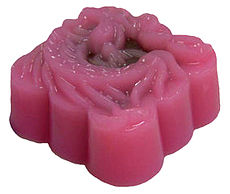
Snowy mooncakes first appeared on the market in the early 1980s. These non-baked, chilled mooncakes usually come with two types of crusts:
- Glutinous rice: A crust with texture similar to that of a mochi. This is a snow skin mooncake. These moon cakes are known colloquially as "snowskin mooncakes", "ice-skin mooncakes" or "snowy mooncakes" (冰皮 or 冰皮月餅).[9]
- Jelly: A crust made of gelling mixtures such as agar, gelatin, or konjac and flavored with a wide variety of fruit flavorings.
Use in other countries
Malaysia
There are 3 major cities that have diverse types of moon cakes. Georgetown, Kuala Lumpur and Sabah. Mooncakes are quite similar to the traditional Chinese. However, many prefer to add 100% pure Hunan lotus seed to maintain the quality of mooncake. The most popular types, especially in Kuala Lumpur, are White Lotus Seed Paste Cake, Snow Skins and Black Sesame With Yolk.[10]
Indonesia
In Indonesia, there several main types of mooncakes,[quantify] from the traditional to the modern mooncakes. The very traditional mooncake has been there ever since the Chinese and Japanese entered Indonesia, they are circular like a moon, white and thinner than regular mooncake. Fillings may include pork, chocolate, cheese, milk, durian, jackfruit and many other exotic fruits made into a paste. This type of mooncake is widely available all year long while the regular modern mooncakes are usually only sold around the mid-autumn festival season. The "modern" mooncakes entered Indonesia after 1998.[citation needed]
Japan
Mooncakes in Japan are known as geppei (月餅), a direct translation of the Chinese name. They are associated with Chinese culture and are sold all year round, mainly in Japan's Chinatowns. Azuki (red bean) paste is the most popular filling for these mooncakes, but other sorts of beans as well as chestnut are also used. Unlike some types of Chinese mooncakes, mooncakes in Japan almost never contain an egg yolk in the center.[citation needed]
Vietnam


In Vietnam, mooncakes are known as Bánh Trung Thu (literally "Mid-Autumn cake"). Vietnamese mooncakes are usually sold in either individually or in a set of four . There are two kinds of mooncake: "Bánh nướng" (baked mooncake) and "Bánh dẻo" (sticky rice mooncake).
It can be said that "Bánh nướng" and "Bánh dẻo" are two special kinds of cake in Vietnam. They are widely popular and are sold year-round. Vietnamese Mooncakes are often in the shape of a circle (10 cm in diameter) or a square (a length of about 7–8 cm), and 4–5 cm thick. Larger sizes are not uncommon. Their designs largely resemble that of their Chinese counterpart, though some other images, such as the sow with cub, fish, shrimp, etc. can also be found.
Vietnamese mooncakes have two basic parts: crust and filling. The ingredients usually consist of: jam, dried sausage, mung bean paste, salt, sugar, cooking oil, sugared lard, lotus seed, watermelon seed, etc. Compared to other variants, Vietnamese mooncakes' flavor is more on the sweet side. Thus, to balance it, salted egg yolk is often added. They can be baked or eaten immediately.
"Bánh nướng"(Baked mooncake) is made from wheat flour, cooking oil, and simple syrup boiled with malt. After being filled with various combinations of salted egg yolk, dried sausage, mung bean paste, salt, sugar, cooking oil, sugared pig fat, lotus seed, watermelon seed, it will be brushed with egg wash, then baked in the oven. The egg wash will protect the crust of the cake from drying out and create the aroma of the cake. The cakes have to be rotated constantly in the oven to prevent burning.
"Bánh dẻo"(Sticky rice mooncake) is easier to make than "Bánh nướng". The crust and filling are pre-cooked. The crust is made from roasted glutinous rice flour, pomelo blossom water or vanilla and simple syrup. After malaxating rice flour, fillings similar to that of baked mooncake is stuffed inside the crust and then the cake is put into the mold dust with a thin layer of flour to prevent sticking to fingers. The cake can be used immediately without any further steps. "Bánh dẻo" is not as popular as "Bánh nướng", however.
Thailand
In Thailand, mooncakes (in Thai, ขนมไหว้พระจันทร์) are sold in Thai-Chinese bakeries during festival season. In Bangkok, traditional and modern moon cakes are not limited to Chinatown on Yaowarat Road, but they are also found in stalls of large supermarkets. Durian-filled mooncakes are ones of the most popular sold,[citation needed] especially with one or two salted egg yolks.
Singapore
In Singapore, mooncakes comes in all kinds of flavours ranging from the traditional baked ones to the Teochew flaky ones to the soft snowskin. The base fillings are usually lotus paste, white lotus paste or red bean paste. There are also a variety of other ingredients like double or single salted duck egg yolks, macadamia nuts, osmantus, orange and melon seeds. It has become a habit to give away mooncakes in beautiful boxes as corporate gifts or to parents.
Types
-
Baked moon cake from Vietnam
-
Wing Wah Mooncake
-
Moon Cakes
-
Mooncake
See also
- Chinese cuisine
- Crystal cake
- List of Chinese desserts
- Mid-Autumn Festival
- Snow skin mooncake
- Suncake
References
- ^ Asianweek
- ^ "Garbage Gift: Hong Kong Threw Away 2 Million Mooncakes". 10 September 2013. Retrieved 5 October 2015.
- ^ Taipeitimes news
- ^ Family culture
- ^ 鳳凰衛視中文台, 12 September 2008
- ^ http://blog.sina.com.tw/extrablue/article.php?pbgid=22988&entryid=159897
- ^ http://www.jingdaily.com/en/luxury/is-a-high-end-mooncake-bubble-forming-in-china/
- ^ http://www.asiatatler.com/hk/top_stories.php?id=4204
- ^ Tiffany Lam; Virginia Lau (29 September 2009). "The Mooncake Challenge". CNN Go. Retrieved 11 August 2012.
- ^ http://ccfoodtravel.com/ http://ccfoodtravel.com/2014/08/top-10-mooncakes-for-2014/.
{{cite web}}: External link in|website=|title=(help)
External links


